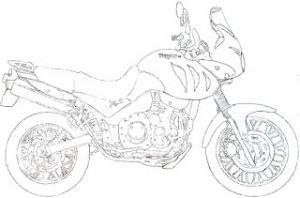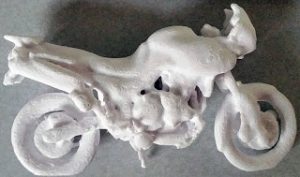 The greatest single downward pressure on the infamous motorcycle equation is the way you’re worked over by insurance for them, especially in Ontario. If you own one bike you’re likely to be paying about $700 a year if you’re an experienced rider. If you’re new you can pretty much double that.
The greatest single downward pressure on the infamous motorcycle equation is the way you’re worked over by insurance for them, especially in Ontario. If you own one bike you’re likely to be paying about $700 a year if you’re an experienced rider. If you’re new you can pretty much double that.
If you buy a second bike, against all logic you’re basically doubling your insurance. Even though two bikes mean you’re only spending half as much time on each, you get nothing back for that.
If the motorcycle industry wanted to sell more bikes, pressuring the Ontario government to make fair insurance premiums would be a good way to do it. If you’re paying $700 a year to ride a bike, it should be less than half that to insure a second bike, not double that. Since you can’t be on both bikes at once your chances of needing insurance drop dramatically. What would be fair would be only applying the stationary insurance (theft, fire, etc) to a second bike, and perhaps a small fee for the paperwork. Owning two bikes does not mean double the liability, which is the lion’s share of an insurance premium.
I’d happily budget $1000 a year instead of the $600 I pay for insurance and triple the number of bikes I’ve got licensed. That’s three times as many vehicles paying road and license plate tax – which helps out the government, and the insurance company themselves would be making more with no increase in liability. If only they could get past the short term money-grab philosophy they currently run with. As it stands the ROI on a $2000 a year insurance bill makes it not worth pursuing.
What would that expanded motorcycle stable look like? Canada’s short riding season means you need to have machine turn-key ready for the few days you can get out and enjoy the weather without it trying to kill you. I’m currently riding a fourteen year old Triumph Tiger as my go-to bike. It has been great, but depending on a bike that old isn’t really fair to it. At The Forks of the Credit last weekend we had the oldest bike there by a decade. I get a great deal of pride out of that, but I don’t want to start hating on the Triumph if it suddenly develops a fault. That happened with the KLX and it was gone shortly thereafter.

A new bike would definitely be in the cards. I’ve long had a crush on Honda VFRs, and they make a great all rounder. A sporty bike that can also cover distances, and when I sat on one they felt quality, almost jewel like. As an it’ll-always-be-ready-to-run, dependable bike, it’s a solid choice. The website is saying this is a $15,000 proposition, but I’m sure I just saw them on sale for a touch over $10,000.

On a naked choice for a new bike I still tend toward the Kawasaki Z bikes. The Z1000 with it’s cat like robotic stance has long scratched an anime aesthetic itch for me, but the new Z900 does too. With the taller comfort seat it would fit me well. The bike is under $10k and looks fantastic. A new Kawasaki, like a new Honda, would be bullet proof and a good choice for an always-ready dependable motorbike. Both the Honda & the Z could also handle track days.

The Tiger does a good job of two up riding (it’s a big bike), but sometimes I miss the road focused athleticism of the Concours. The new one looks spectacular in Candy Imperial Blue. As a two up tourer it approaches the Goldwing and other dedicated touring machines, but it retains its sports bike heritage, evaporating weight and feeling more like a Ninja in the corners. It’s a big bike, but I’m a big guy and I look like I fit on it. With a dedicated long distance road tool like this, perhaps the Tiger would become more adventury in purpose.

With the Tiger and one of the above on hand, in a more insurance friendly situation I’d also have a third bike that would let me focus on the off-road aspects of riding.
I learned that a 240lb guy on a KLX250 does not add up, so I’d be looking for a 300+cc off roader so that I could keep up with traffic when on the road.
The DRZ-400 Suzuki has long looked like the bike of choice. They come up occasionally online. If insurance weren’t killing it, I’d already own one. With some frame guards and good sump protection, this would be the bike I’d trail ride and explore farm tracks on without worrying about a traffic line up behind me when I’m on the road.
 The Tiger is dependable and a good two up ride, so I suspect I’d pass on the Concours. Today the three bike stable would be the Tiger, the VFR and the DR-Z 400; a Triumph, a Honda and a Suzuki, but in other circumstances it could be a Kawasaki heavy garage. If the Tiger weren’t the brick house that it is, I’d have a Concours, a Z900 and maybe even a KTM in the stable… if only I could pay fair insurance rates on them.
The Tiger is dependable and a good two up ride, so I suspect I’d pass on the Concours. Today the three bike stable would be the Tiger, the VFR and the DR-Z 400; a Triumph, a Honda and a Suzuki, but in other circumstances it could be a Kawasaki heavy garage. If the Tiger weren’t the brick house that it is, I’d have a Concours, a Z900 and maybe even a KTM in the stable… if only I could pay fair insurance rates on them.
from Blogger http://ift.tt/2pea5uo
via IFTTT
![]() The writing didn’t slow down, it just changed focus. Putting experience into words allows me to meditate on that experience and clarify my thinking about it. It’s nice to know that whatever I’m doing, writing is a natural response to it.
The writing didn’t slow down, it just changed focus. Putting experience into words allows me to meditate on that experience and clarify my thinking about it. It’s nice to know that whatever I’m doing, writing is a natural response to it.



















